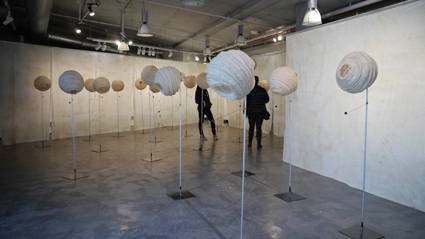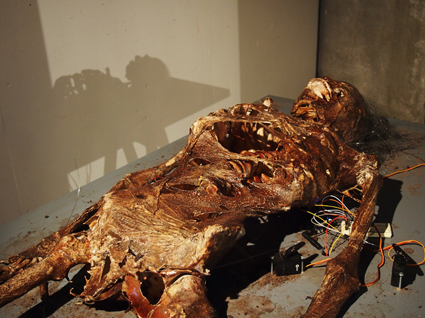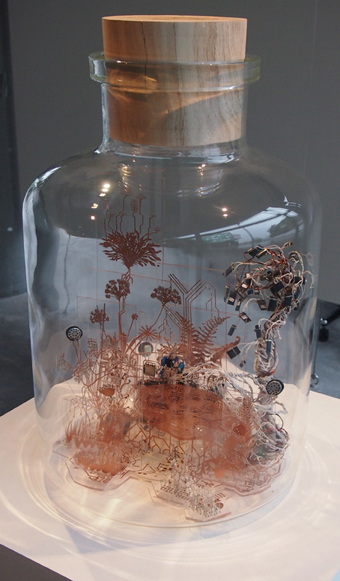July 24 2013
Past-present tensions
Keith Gallasch, Naala-Ba (Look Future), Carriageworks and ISEA2013
July 3 2013
Data noise & the limits of dance
Keith Gallasch, Myriam Gourfink & Kaspar Toeplitz, Breathing Monster
June 26 2013
Nailing the virtual
Virginia Baxter, Keith Gallasch, The Portals
Night work
Keith Gallasch, Embodied Media, Night Rage
Palpable virtualities
Keith Gallasch, Paula Dawson, Holoshop: Drawing and Perceiving in Depth
The big connect
Somaya Langley, The Portals
Transformational walking
Anne Phillips, Long Time, No See?
June 18 2013
Musical multiverses
Gail Priest, Polysonics
Rainbow over ISEA
Keith Gallasch, Electric Nights
realtime tv @ ISEA2013: Zydnei, Troy Innocent
June 17 2013
If a system fails in a forest, is anybody listening?
Urszula Dawkins, If a system fails in a forest…, 107 Projects
June 16 2013
In the digital age, love your stationery obsession
Urszula Dawkins, Durational Book
Painting by algorithms
Keith Gallasch, Ernest Edmonds: Light Logic
June 15 2013
Home, sweet home
Urszula Dawkins, disSentience, Sleeth, SelgasCano, Tin Sheds
Pop up pleasure zones
Gail Priest, Electronic Art Pop-Ups, The Rocks
June 14 2013
Aural ecologies, mechanical and musical
Urszula Dawkins, EchoSonics, UTS Gallery
June 14 2013
Heck, baby, I shoulda seen it comin…
Urszula Dawkins, The Very Near Future, Alex Davies
More than meets the eye
Virginia Baxter, Keith Gallasch, Point of View
New tools and old skool grammars
Gail Priest, Macrophonics II
realtime tv @ ISEA2013: The very near future, Alex Davies
Start by leaping off a small stool
Urszula Dawkins, ISEA Closing Keynote Address: Julian Assange
June 13 2013
A curative dose of spontaneity
Lauren Carroll Harris, pvi collective, Deviator
M e d i a a r t t h e n a n d n o w
Darren Tofts, Catching Light, Campbelltown Arts Centre
Olfaction, decay & speculation
Gail Priest, Raewyn Turner & Brian Harris, Ian Haig, Nandita Kumar, Verge Gallery
ART, WELLNESS & DEATH
Riding the theta waves
Urszula Dawkins, Theta Lab, George Poonkhin Khut and James Brown
Run for your lives [2]
Keith Gallasch, Running the City, COFA, UNSW
To re-map and reclaim
Lisa Gye, Mapping Culture [panel]
Turning the media back on itself
Lisa Gye, Mark Hosler, Adventures in Illegal Art
June 12 2013
Outside the labyrinth…looking in at someone waving
Urszula Dawkins, SoundLabyrinth, Mark Pedersen and Roger Alsop
realtime tv @ ISEA2013: semipermeable (+), SymbioticA
Run for your lives [1]
Keith Gallasch, Marnix de Nijs, Run Motherfucker Run
June 12 2013
The uncanny in the gallery
Keith Gallasch, Mari Velonaki, Simon Ingram, Petra Gemeinboeck & Rob Saunders, Artspace
June 11 2013
realtime tv @ ISEA2013: EchoSonics, UTS Gallery
The science and art of tangible things
Urszula Dawkins, Synapse: A Selection, Powerhouse
Touch me there
Gail Priest, ISEA Artist talks: Siu, Baumann, Velonaki
June 10 2013
Being Stelarc
Gail Priest, Stelarc: Meat, Metal, Code: Engineering affect and aliveness
Life and death, and the membranes inbetween
Urszula Dawkins, semipermeable (+), SymbioticA
realtime tv @ ISEA2013: Catching Light, Campbelltown Arts Centre
June 9 2013
'Pure' experience, in the round
Urszula Dawkins, Pure Land, iCinema
Data lives
Gail Priest, Genevieve Bell, Mark Hosler, Paolo Cirio & Alessandro Ludovico
realtime tv @ ISEA2013: Velonaki, Ingram, Gemeinboeck & Saunders, Artspace
June 8 2013
Knowing your place in Cartesian space
Gail Priest, Ryoji Ikeda, datamatics [ver 2.0]
Stars and starlings, pixels and picknickers
Urszula Dawkins, Ryoji Ikeda, datamatics [ver 2.0] & test pattern
 |
Raewyn Turner & Brian Harris, Downwind
photo Gail Priest |
The twitter hash tag for ISEA—#iseeISEA—has attracted some light-hearted criticism. Why perpetuate the dominance of the visual? Why not #ihearISEA? Or even #ismellISEA?* At the Verge Gallery, University of Sydney, you can actually cop a whiff.
In my previous blog piece “Touch me there” I discuss some artists who are exploring mediated touch and this got me thinking about the other less art-privileged sense of smell. Never fear, ISEA2013 has a little bit of everything and New Zealand artists Raewyn Turner and Brian Harris are tackling the challenge of mediated olfaction.
Raewyn Turner & Brian Harris, Downwind
Downwind is a gently interactive work—you are invited to approach a sugar bowl which politely opens for you. Then you place a small amount of sugar on your tongue to heighten your sense of smell. Forming a kind of poppy field, the other objects look like mutant lamps with spherical ‘shades’ that concertina in and out, responding to your presence. This movement puffs air in your face, carrying a scent somehow stored within. These scents are quite subtle yet complex and hard to categorise—maybe there’s tobacco, grass, tea but I can’t be sure. Many seem to have synthetic top notes that mingle with the organic and create the olfactory equivalent to glimpsing something out of the corner of your eye—smelling from the edge of your nose perhaps?
It is this ambiguity that the artists are interested in—the myriad combination of smells that comprise the scent of a human (hopefully without employing some of Patrick Susskind’s suggested techniques in his 1985 novel Perfume). Enclosing the space are large draped white plastic sheets, marbled with suspiciously yellow stains, a patterning that also adorns the pods. Creating a unified visual field, these sheets are also impregnated with scent—a fermenting hopsy smell of unwashed human, but I could be wrong. That’s the point. Turner and Harris are interested in the way in which smells are variously interpreted by individuals, thus rendering each reality unique. That smell so sweet to one person may be repugnant to another—smell as a signature of subjectivity. Downwind is sensorially and conceptually satisfying.
Ian Haig, Night of the Living Hippy
 |
Ian Haig, Night of the Living Hippy
courtesy Verge Gallery |
Ian Haig’s Night of the Living Hippy is well served by its juxtaposition with Turner and Harris’ Downwind and vice versa. The heightened olfactory state adds an extra dimension to Haig’s twitching, desiccated cadaver. We are assured by the wall text that the skeleton is plastic; but the mummified skin, tufts of hair and gouts of unidentifiable decaying matter are rather convincing. Parts of the skeleton are connected via guitar strings to Arduino micro controllers tugging and pulling bones in rhythmic sequences. All the mechanics are visible so it is not as if we are expected to buy the illusion of self-activated movement, rather it looks like extended torture—this body is subject to perpetual artificial stimulation, never allowed to finally rest.
The work references Paul Thek’s 1967 piece The Tomb (also known as the Death of a Hippy); ironically, it was destroyed for lack of storage in 1972 (see the Gallery of Lost Art). Thek himself died in 1988; Haig’s skeleton serves as a representation of Thek’s body and his lost artwork. In his artist note Haig also suggests a narrative for the arts in general in which nothing remains dead or static; everything that has come before is material to be re-utilised and re-animated. This thinking around the relationship of old and new technologies and their re-combination has flowed through much discussion at the ISEA2013 conference, neatly taxonomised as “post-digital.” Haig’s hippy is perhaps a post-digital post-human.
Nandita Kumar, eLEMenT: EARTH
 |
Nandita Kumar, eLEMenT: EARTH
courtesy Verge Gallery |
Indian artist Nandita Kumar’s eLEMenT: EARTH sits in contrast to the implied fleshiness (or lack thereof) of the other two pieces offering a clean, tech-fetishist aesthetic. The artist has created a beautiful and intricate garden—enclosed in a large glass jar—made from circuits, tiny speakers and sensors. It’s a future fantasy in which technology has been integrated into nature, and this new alliance has led us back to the Garden of Eden. Responsive to movement, the piece also emits a delicate sound track of increasing densities and intensities that draws you further into its magic diorama.
Kumar’s piece reminds me of Ursula LeGuin’s sci-fi utopias. Interestingly, after viewing the exhibition I went to the conference session on science fiction in art, where Amelia Barakin eloquently discussed the correlation of “world making” in science fiction literature and in visual art processes. Lizzie Muller offered the idea of speculative objects to augment speculative fictions—objects that prompt us to dream of alternate ways of being. Nandita Kumar’s eLEMenT: EARTH perfectly embodies both these concepts, while also connecting to the sensory and visceral preoccupations of the other two works which it accompanies.
Raewyn Turner & Brian Harris, Ian Haig, Nandita Kumar, Verge Gallery, 8-16 June; http://www.isea2013.org/
This article first appeared on RT's ISEA2013-in RealTime blog
* courtesy Sarah Last
© Gail Priest; for permission to reproduce apply to [email protected]
Back to top











 back
back